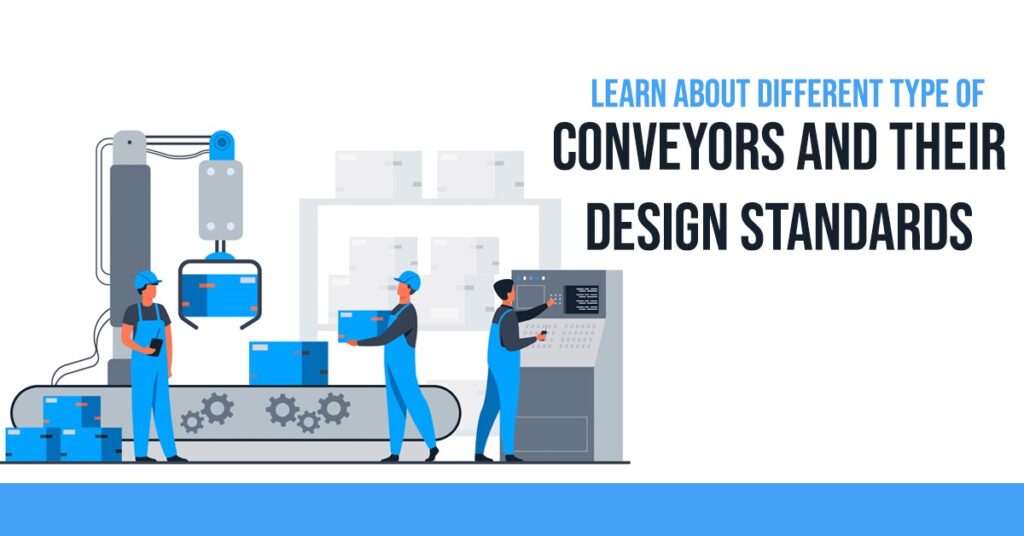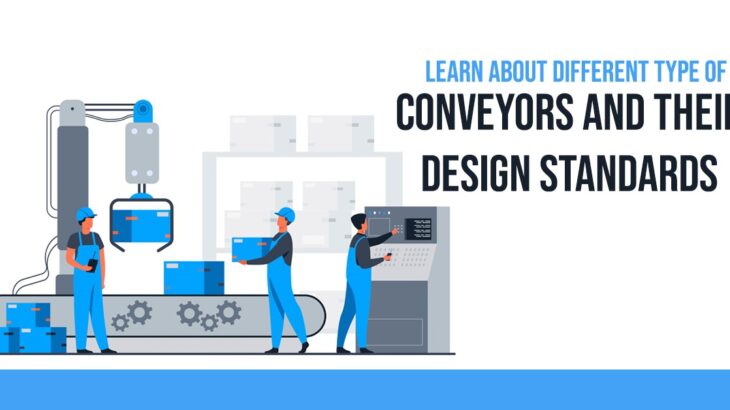
Conveyors are used to transport materials or goods from one location to another within a facility or from one place to another. There are several types of conveyors designed for various purposes and industries. Here are some common types of conveyors:
Belt Conveyors: Belt conveyors consist of a continuous loop of material, typically a rubber or fabric belt, that is used to move items from one point to another. They are widely used in manufacturing and distribution facilities.
Roller Conveyors: Roller conveyors use rollers to move items along a fixed path. They are often used for the transportation of heavy objects or for accumulating items in assembly or packing lines.
Chain Conveyors: Chain conveyors use a chain as the driving mechanism to move items along a path. They are often used in heavy-duty applications, such as in the automotive industry for painting or assembly lines.
Screw Conveyors: Screw conveyors use a rotating helical screw to move materials in a spiral fashion. They are often used for handling bulk materials like grains, powders, and sludges.
Pneumatic Conveyors: Pneumatic conveyors use air pressure to transport materials through pipes or tubing. They are often used in industries where cleanliness and containment are critical, such as in the food and pharmaceutical industries.
Bucket Elevators: Bucket elevators are designed to vertically lift materials using a series of buckets attached to a belt or chain. They are commonly used in industries like agriculture and mining to move bulk materials vertically.
Overhead Conveyors: Overhead conveyors use a track system installed above the working area to move items from one location to another. They are often used in painting lines, storage facilities, and automotive assembly.
Vibrating Conveyors: Vibrating conveyors use vibrations to move materials. They are suitable for applications where a gentle conveying action is required, such as in food processing and recycling.
Slat Conveyors: Slat conveyors use slats or plates to move items along a path. They are commonly used in the automotive and beverage industries.
Flexible Conveyors: Flexible conveyors are adjustable and can be extended or retracted as needed. They are often used for loading and unloading trucks, as they can be moved to different positions easily.
Gravity Conveyors: Gravity conveyors use the natural force of gravity to move items along a declining path. They are often used for simple material handling tasks like moving boxes or cartons.
Magnetic Conveyors: Magnetic conveyors use magnets to move ferrous materials. They are commonly used in the metalworking industry.
Each type of conveyor has its unique advantages and is chosen based on the specific needs of the application, including the type of material being transported, the distance, the speed required, and the environmental conditions.
Most commonly used Conveyors
The most used type of conveyor depends on the specific industry and application. However, in general, belt conveyors and roller conveyors are among the most used conveyors across various industries and material handling tasks. Here’s a brief overview of each:
Belt Conveyors: Belt conveyors are widely used in industries such as manufacturing, distribution, mining, and agriculture. They consist of a continuous loop of material, typically a rubber or fabric belt, that moves items from one point to another. Belt conveyors are versatile, suitable for various materials, and can handle both heavy and light loads. They are often used for horizontal and inclined transportation and are commonly found in assembly lines, baggage handling systems at airports, and warehousing.
Roller Conveyors: Roller conveyors utilize rollers, typically made of metal or plastic, to move items along a fixed path. They are frequently used for conveying heavy objects or accumulating items in assembly or packing lines. Roller conveyors come in various configurations, including gravity roller conveyors (where items are moved by gravity) and powered roller conveyors (where rollers are driven by motors). Roller conveyors are commonly used in material handling and distribution centers.
These two types of conveyors are versatile, cost-effective, and suitable for a wide range of applications, which is why they are often considered the most commonly used conveyors. However, the choice of conveyor type ultimately depends on the specific requirements and constraints of the task at hand. Other types of conveyors may be preferred for specialized applications, such as screw conveyors for bulk material handling or overhead conveyors for specific production processes.
Important standards used to design conveyors
When designing conveyors, it’s essential to adhere to relevant industry standards to ensure safety, reliability, and compliance with regulations. Here are some of the main design standards commonly used in conveyor design:
CEMA (Conveyor Equipment Manufacturers Association) Standards: CEMA is a leading organization that provides guidelines and standards for designing conveyors. Their standards cover various aspects of conveyor design, including dimensional, load, safety, and construction standards. Some notable CEMA standards include CEMA 350 for screw conveyors and CEMA 401 for belt conveyors.
ISO (International Organization for Standardization) Standards: ISO has several standards related to conveyor design, including ISO 1536 (Belt conveyors – Calculation of operating power and tensile forces), ISO 5048 (Continuous mechanical handling equipment – Belt conveyors with carrying idlers – Calculation of operating power and tensile forces), and ISO 2148 (Conveyor belts – Specification for rubber or plastics-covered conveyor belts of textile construction for general use).
ASME B20.1: Safety Standard for Conveyors and Related Equipment: The American Society of Mechanical Engineers (ASME) B20.1 standard provides guidelines for the design, construction, installation, operation, inspection, and maintenance of conveyors. It includes safety considerations and requirements.
OSHA (Occupational Safety and Health Administration) Standards: OSHA in the United States sets workplace safety standards, and these standards apply to conveyor systems. Conveyor designers should be aware of OSHA and other SDS regulations to ensure the safety of personnel working with or near conveyors. Sunstream offers you the best SDS services for your workplace safety.
EN (European Norm) Standards: In Europe, conveyor design may be subject to various EN standards that cover safety, construction, and performance requirements for conveyors. EN 619:2002+A1:2008 is one example, which relates to safety requirements for the design and construction of conveyor belts.
DIN (German Institute for Standardization) Standards: The DIN standards are widely used in Germany and provide guidelines for various aspects of conveyor design, including construction and safety. DIN 22101, for example, is used for the design of belt conveyors.
ANSI (American National Standards Institute) Standards: ANSI offers standards related to safety and performance considerations for conveyor systems. ANSI B20.1, similar to ASME B20.1, covers safety standards for conveyors.
NFPA (National Fire Protection Association) Standards: NFPA standards may apply to conveyors used in hazardous environments or when handling materials that pose fire risks. NFPA 654, for example, provides guidelines for the prevention of fire and dust explosions in the design and construction of conveyors.
Local and Industry-Specific Standards: Depending on your location and the specific industry in which the conveyor will be used, there may be additional regional or industry-specific standards to consider. These could include guidelines for food handling, pharmaceuticals, mining, and more.
It’s important to check with the relevant regulatory authorities and organizations to ensure that your conveyor design complies with the appropriate standards and regulations. Adhering to these standards helps ensure the safety and performance of your conveyor system and can help prevent accidents and compliance issues.
Sunstream’s engineering team is well experienced in working on different type of conveyors. Our mechanical design services team can do design, provide 3D modeling solutions and mechanical drafting services for conveyor manufacturers. Sunstream is also experienced in providing mechanical analysis services including FEA analysis services for these products. Reach out to us to know how our mechanical design and 3D CAD services team can work along with your team in your next conveyor design project.




 +1.585.935.7123
+1.585.935.7123 +91-804-148-6861
+91-804-148-6861